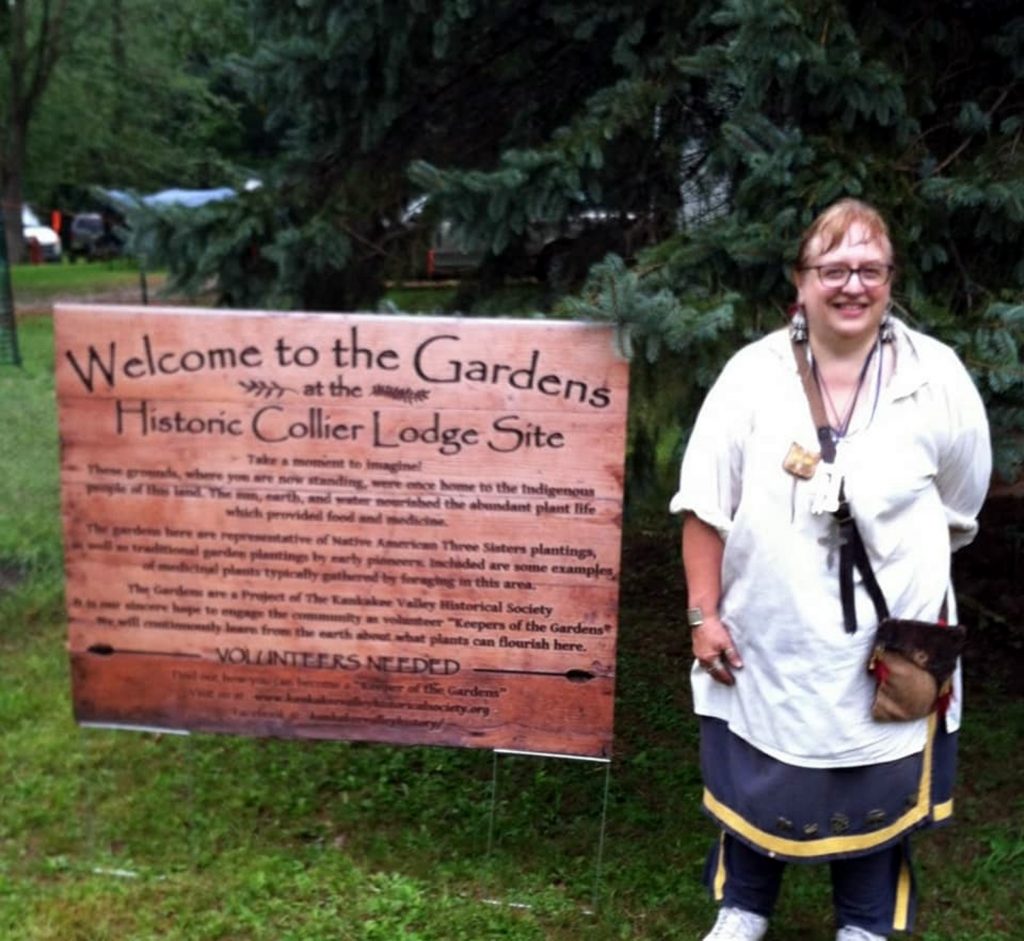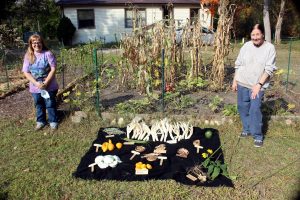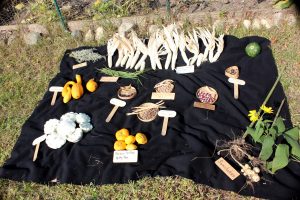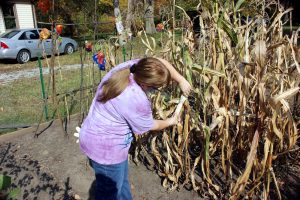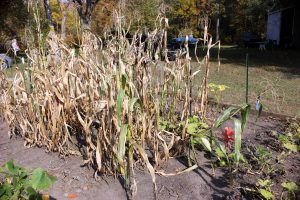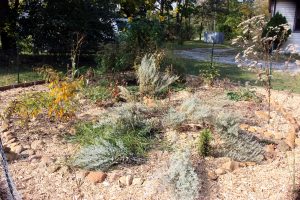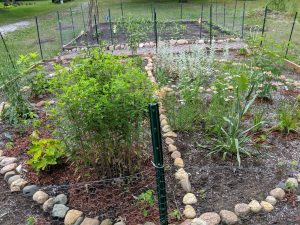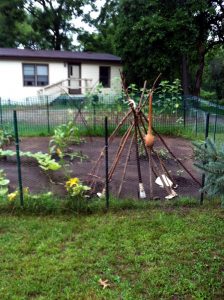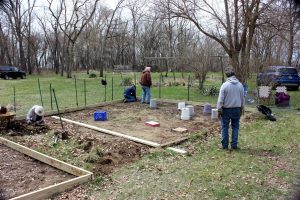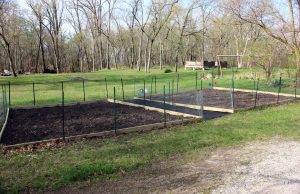October 11, 2020
It’s hard to believe that fall is here and the farmers are busy bringing in their crops. Our volunteers Cindy Deardorff and Judy Judge have been harvesting and gathering seeds from our Collier Lodge gardens too.
The three sister’s garden and native plant medicine wheel garden did fairly well considering the hot dry summer we had. Cindy and Judy watched the gardens carefully and watered them when needed.
We added the following new plants: Prairie Blazingstar, Rough Blazingstar, Royal Catchfly, Partridge Pea and Bearberry bush to our wheel garden.
At the three sister’s garden, the following was planted:
Miami White flour corn, – Seed was received from the U.S. national Plant Germplasm System in Ames, Iowa. The Miami were known for growing white seed corn. When ground it resembled wheat flour. Jacques-Charles de Sabbrevois de Bleury was commander at Detroit from 1715-1717. Wrote this about the Miami: The women were very industrious and raise a kind of Indian corn which is unlike that of our tribes at Detroit. Their corn is white of the same size as the other with much finer husks and much whiter flour.
Eariv Yellow Summer Crookneck – This is one of the oldest documented varieties of squashes. Dating back from around the 1700’s and possibly earlier. Thomas Jefferson raised this squash at Monticello. It is the only squash that can be documented to the Lenape People.
White & Yellow Bush Scallop or Patty Pans – Date from pre-Columbian times. This is another early known squash grown by the American Indians of the eastern United States. The natives called this “Symnel” or Cymling” Very popular during colonial times. It has even appeared in a painting from 1591.
Potawatomi Lima Beans (Pole) – Lima beans are a very old documented New World bean traceable to Mexico and Peru. The Spanish brought this bean to Florida and traded among the Indian nations and probably traded up to the Potawatomi.
Seneca Indian Bear Paw (Pole),-This is a runner bean that has red flowers attracting humming birds. It is also known as the Scarlet runner bean dating back to 1750. This variety is known to come from the Iroquois nation, Seneca.
Potawatomi Rabbit Bean (Pole) – native name “Owamawin” This seed is actually in the cow-pea family. From the Potawatomi Reservation in Kansas. It may have come from the Potawatomi scouts that went into Mexico in the 1800’s or from the Spanish bringing it from Africa and traded to the native nations.
Potawatomi/Miami Bean (Pole) -18th, early 19th century Indiana shell bean. This bean is in the same family as the speckled cranberry beans which is a very common native bean from the East coast to the Great Lakes region with slight variations in sized and coloration of beige & red markings.
Seneca Sunflower – A sunflower with medium to large seed heads with seeds in mixed sizes and colors. The Seneca traditionally crushed the seeds in a mortar and boiled them to extract the oil. The darker seeds were used in dyes. Seeds were used in many native food dishes.
Sunchokes (Jerusalem Artichokes) – These are in the sunflower family and are native to North America. Samuel Champlain, a French explorer was given them to eat in 1605 by natives. Tubers are the best to harvest after the first frost. The tubers look like small knobby potatoes that can be eaten raw, boiled and baked. Some native sites have been found because these were found growing in the area.
July 1, 2020: This year’s KVHS gardens are doing great! Our volunteers Cindy Deardorff and Judy Judge have been hard at work and we finally got some much-needed rain!
Cindy and Judy have planted seeds associated with the native tribes known to live in northern Indiana. They have planted Miami white flour corn, Miami squash, Miami/Pottawatomie cranberry beans, Lima, and rabbit beans. They have also added Seneca bear beans and sunflowers, Illinois red seeded watermelon and summer yellow crookneck and white patty pans known to be grown by the native eastern tribes since the 1700’s. Can’t wait for the harvest to come in!
Our medicine wheel garden is equally as great. First planted in 2019 with native plants that have medicinal properties, plants that are edible, plants sacred to the native people and plants that attract butterflies and bees. We have added more wonderful native plants this year including: blazing star, royal catch fly, bearberry shrub, whorled milkweed, spiderwort, hyssop, and rough blazing star.
Cindy has harvested our first wild strawberries.
Do you like the postings at our KVHS website page? Do you enjoy reading the amazing stories of the Kankakee River? If you would like to support KVHS and be part of our mission to promote Kankakee River, we would love for you to join with us. The best way to help us is to become a KVHS member. Please, go to our KVHS membership page and fill out our online application, or mail in a hard copy of our application. Our online application now takes credit card payments! Go here to our membership and donation page: http://kankakeevalleyhistoricalsociety.org/?page_id=146
A Native American Three Sisters Garden consists of corn, squash, and beans. Tribes in the Kankakee River area, such as the Potawatomi and Miami, planted the Three Sisters in mounds about three ft. in diameter and about one foot high in the center. Corn is first to be planted in the hills. After the corn has reached about 6 to 8 inches tall beans are planted.The beans are planted two ways. First they can be planted next to the corn. One or two seeds at most per hill. This will allow your corn to pollinate correctly. Some of the beans were then planted in their own hills supported by a tripod of branches from nearby trees. The squash seeds were planted on the outer sloping circle of the mound. The bean roots help stabilize the corn and provide it with valuable nitrogen. The squash plants, which tend to ramble, shade the roots of the corn and beans to conserve water. It was common to find sunflowers also planted. The sunflower seeds were used for food and oil. They were also used to support climbing beans in the garden. It is important to remember, there were many different variations among the tribes for their gardens. Not all tribes planted in mounds, but you will find this a very common practice.
A Native American Medicinal Garden actually didn’t truly exist in the traditional sense. This is a special place where we have planted some examples of food plants harvested in the wild, sacred plants for ceremony, medicinal plants, and common plants found in the Kankakee Marsh area used by the native people.
The Medicine Wheel has been used by generations of various Native American tribes for health and healing. The Medicine Wheel can take many different forms.
We have chosen to make a garden for you to learn about these very special plants. Some of these plants can be considered becoming endangered so as we make attempts at restoring the marsh, we can also save these very important plants that you may find wild in this area into one garden plot. Some Indigenous healing plants from our local area featured here are:
Blood Root (Sanguinaria Canadensis – also known as Bloodwort, and Indian Plant): Blood Root a perennial flowering plant. The rhizome (or root) of this plant contains chemicals that help fight bacteria, inflammation, and plaque. Traditionally, it was used to treat sore throats, wounds, and tooth/gum ailments, among other things.
Wild Bergamot (Monarda Fistulosa – also known as Bee Balm): Wild Bergamot is a perennial flowering plant. The blossoms of this plant contain chemicals that work as an anti-inflammatory, an antiseptic, along with other uses, such as being made (sometimes also with the leaves) into tea to treat colds and flu.


